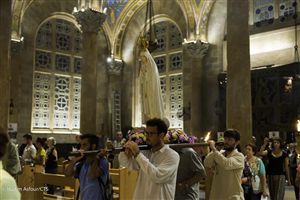THE VIGIL IN GETHSEMANE. At the garden of the Apostles at Gethsemane, the faithful gathered slowly. Among the crowd, in the darkness of the evening, a voice broke the silence to proclaim the beginning of the prayer. On July 14, with the Vigil in Gethsemane, the feast of the Assumption of the Virgin Mary began. The celebration is seemingly just like so many others, yet the strength of this holy place that has honored the Virgin Mary for centuries turned the prayer into an exceptional event.
Mary’s life was recalled in the Gospel reading and then it was time for the story of the Virgin’s transit, recalled with an apocryphal tale. In his homily, Fr. Giorgio Vigna of the Gethsemane fraternity emphasized the extraordinary nature of Our Lady, which was God’s pure grace: “Today we are invited to have a fixed look on Mary, the woman of the impossible. And today I want to remember her not only as the mother of God, but as the mother of hope.” The statue of Our Lady was there, being looked upon by those present, so as to represent that mother to whom their deepest prayers are addressed daily.
One could feel the emotion of the many pilgrims, among the songs sung by the friars of the Custody of the Holy Land, the statue of Our Lady that came with the procession through the garden of Gethsemane to the Basilica of of the Agony. This is where an excerpt from the Transito Romano was proclaimed:
The Lord told Michael to elevate Mary’s body onto a cloud and move it to Paradise. When the body was raised, the Lord commanded the clouds to go toward the East, toward the region of Paradise.
THE MASS OF THE ASSUMPTION. The feast of the Assumption has ancient origins, so much so that as early as the fifth century, the date of August 15 was mentioned at the church of the Kathisma. The “kathisma,” or Mary’s “rest,” was celebrated along the way to Bethlehem, but the fact that this rest could also evoke an eternal rest is also taken into consideration. Subsequently, the liturgical assembly gathered in Gethsemane to commemorate the Assumption and two different traditions were created because they moved the celebration of the Kathisma to August 13. The tradition that took over was the one that was moved to August 15, but it was only in 1950 that Pope Pius XII proclaimed the dogma of the Assumption of Mary.
On August 15, the Basilica of the Agony was again crowded with faithful for the celebration of the mass of the Assumption. Presiding over it was Fr. Dobromir Jasztal, the custodial vicar, while, Fr. Nerwan, parish priest of St. Savior’s, said the homily for the local Catholics. “With faith, we ask the Lord for us to be able to experience our time of this earth looking toward higher things, promised by the Lord and accomplished in Mary’s life,” said Fr. Benito José Choque, guardian of the Gethsemane fraternity.
THE JOY OF THE FEAST. During the small refreshment that was held outside the Franciscan monastery, several pilgrims still carried with them the joy of having attended the celebration in Gethsemane. Rosi, a pilgrim from Mexico said: “Mary is our mother, the mother of all. She is an example to follow for her obedience.” Among the reactions to the solemnity of the Virgin Mary, there were also two surprised tourists from Chicago, who did not even know about the feast and who saw the enthusiasm of the faithful in Gethsemane. “This is a unique opportunity to experience this place with Christians. We are usually in Italy for this feast, but being in the place where these events took place has made a big difference,” explained a pilgrim from the Vicenza province in Italy. A pilgrim from the same group said, “Despite the difficulties and being tired, we are here to pray with the Christian community so that we can look toward our near and ultimate futures with hope.”
PROCESSING TOWARD MARY’S TOMB. A last important event was needed to complete the Assumption Day celebration, as is always done in the Holy Land: the procession from the grotto in Gethsemane to Mary’s tomb. This is the only time of the year that the Franciscans can officially process to this place, according to the [rules of the] Status Quo, and this year they have once agian followed the tradition. After Vespers at the grotto, the friars led the faithful into Mary’s tomb, and they were greeted by representatives of the Greek Orthodox and Armenian communities. Singing to the Virgin Mary, one by one, everyone knelt before the Mother of Jesus.


